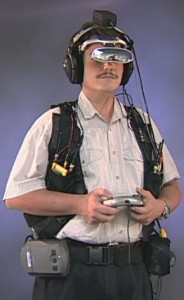Looking Outwards – Wearable Computing
Often I see articles in Make Magazine and other maker-themed publications featuring wearable computing projects. Wearable computing is the idea that computing devices can be embedded in our clothing to augment our experience with electronically-accessible information. Using these devices we can become more aware of our surroundings and sense things beyond our natural senses. The field is increasingly popular in forward-thinking research environments like IDEO and The MIT Media Lab. Often I’m impressed by the technology used in the projects, but end up doubting I’ll be putting LEDs into my clothing anytime soon.
Typing wearable computing into Google Images gives you an idea of the problem. Wearable computing at its best is quirky—a wearable coin-slot detector, Leah Buechley’s turn signal biking jacket—and at its worst (the stuff Google finds) it’s clunky, distracting, and unattractive. Most projects take the form of clunky wristbands, goofy goggles, and stiff vests covered in wires. Some broadcast unnecessary information in a noisy way that doesn’t do favors for anyone. Most people don’t care to see a readout of your heartbeat on your earrings or watch TV on your t-shirt. There’s a reason why the sound equalizer shirt is sold exclusively at ThinkGeek.com.
In the real world, our clothing communicates in much subtler ways that the flashing of an LED: buttoned or unbuttoned, baggy or tight, neck lines, sweat stains, and wrinkles. If wearable computing is to succeed with a mainstream audience I believe it will have to learn to speak their language. Instead of forcing information through new, uncomfortable, and often unfashionable modes of fabric-based communication, wearable computing should be executed using the metaphors we’ve already created through thousands of years of expression through fashion.
Adidas’s Adidas 1 sensor shoe does a good job of embedding technology in an easy-to-grasp form. I believe projects like these will make wearable computing easier for people to accept.
Of course, I shouldn’t entirely discount the clunky visors and flashy t-shirts. Often the avant-garde ends up assimilating into the mainstream over time. It’s entirely possible that someday we could be wearing augmented reality goggles to work every day. In addition, projects like these were important in spawning the LilyPad Arduino, wider distribution of conductive thread, and other building blocks for future computing textile innovation. However, I think there’s room for a more refined implementation of technology in clothing that is less Star Trek and more Devil Wears Prada. Because, really, I would love to have a TV on my shirt if only I could wear it without being laughed at.

Good discussion. So, can you swallow hard and try to find some wearable projects you actually like? 🙂
That was a bit of a rambling rant, wasn’t it? I’ll try hard to be positive next time. 🙂